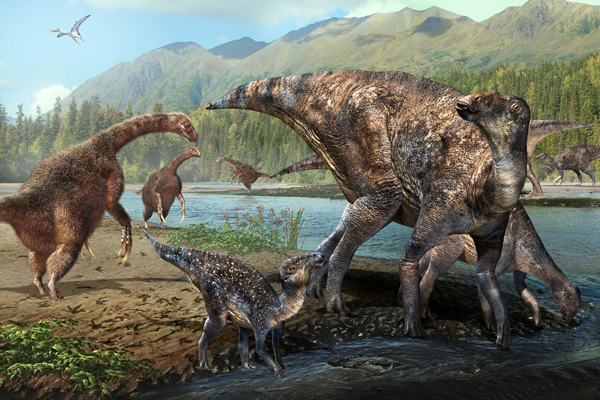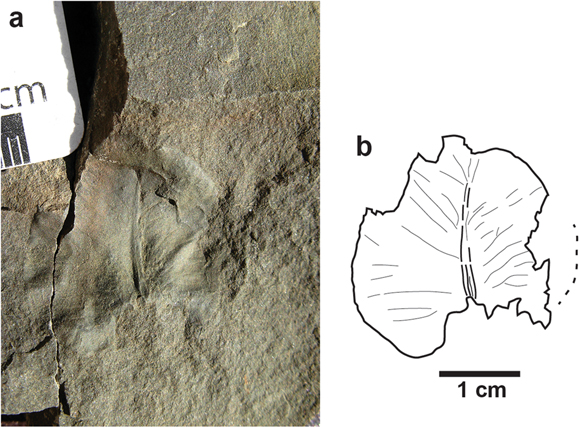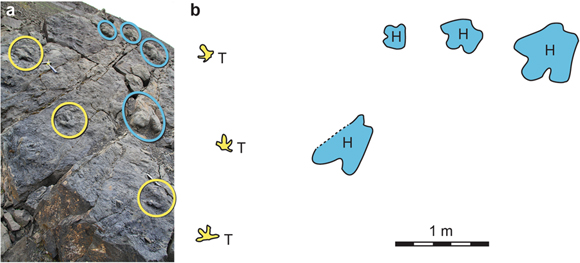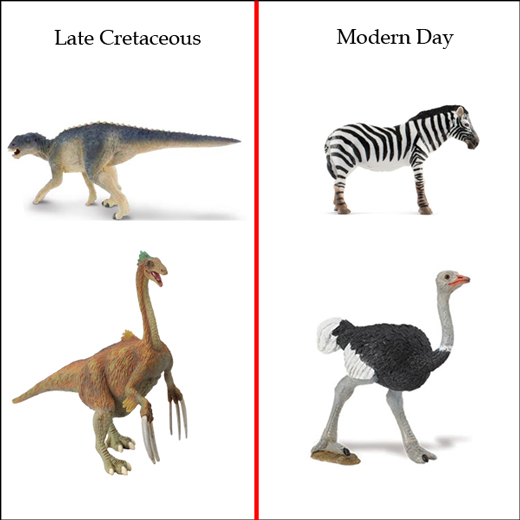Scientists Describe Therizinosaur and Hadrosaur Tracks from Alaska
A team of international scientists have published a report on a series of dinosaur trackways found in Upper Cretaceous rocks located in Denali National Park, Alaska. The tracks show the presence of duck-billed dinosaurs (hadrosaurs) and bizarre herbivorous theropods (Therizinosaurs), in the same location at potentially the same time. If this is the case, then it could be speculated that these very different dinosaurs benefited from an association, just as some animals today congregate together for mutual benefit.
The hadrosaur and therizinosaur trackways represent the first report from North America of co-occurrence between these very different dinosaurs and the trace fossils support the idea that the dinosaur population in Alaska in the Late Cretaceous was similar in composition to that associated with Asia (Nemegt Formation). Alaska could have been a “highway” linking the dinosaur faunas of Asia with the North American continent.
Did Therizinosaurs and Hadrosaurs Live Side by Side?

Picture credit: Masato Hattori
Hadrosaur and Therizinosaur Tracks – It Started with a Single Footprint
The lower Cantwell Formation represents a series of sedimentary deposits laid down in a terrestrial environment and fossil pollen analysis suggests a Late Campanian to early Maastrichtian temporal setting (73-71 million years ago). Numerous vertebrate and plant fossils are associated with this strata, vertebrates including fishes, pterosaurs and numerous dinosaurs. Lead author of the paper, published in the journal “Scientific Reports”, Anthony Fiorillo, (Perot Museum of Nature and Science, Dallas, Texas), had previously described a single four-toed print found in the area back in 2012. This track was identified as having been made by a therizinosaur and was the first evidence found of these strange theropods living at such high latitudes.
To read more about the 2012 fossil discovery: Potential Therizinosaur Track Discovered in Alaska.
The discovery of a single fossil leaf, resembling that of a waterlily from the same site as the therizinosaur and hadrosaur trackways suggest the prints were made by dinosaurs as they crossed a shallow body of water away from the main river channels. During the Late Cretaceous this part of North America was a vast wetland habitat.
A Photograph and Line Drawing of the Waterlily Fossil

Picture credit: Scientific Reports
A More Detailed and Thorough Mapping of the Area
A field team returned to this location in 2013 and 2014 an mapped a series of dinosaur tracks, unearthing dozens more four-toed tracks that were identified as therizinosaur prints. The researchers were surprised to discover that the therizinosaur tracks seem to co-occur with lots of tracks indicating herds of hadrosaurs.
Commenting on the significance of these trace fossils, Dr Fiorillo stated:
“Hadrosaurs are very common and found all over Denali National Park. Previously, they had not been found alongside therizinosaurs in Denali. In Mongolia, where therizinosaurs are best known, though no footprints have been found in association, skeletons of hadrosaurs and therizinosaurs have been found to co-occur from a single rock unit so this was a highly unusual find in Alaska and it prompted my interest.”
A Photograph and Accompanying Diagram Showing Some of the Associated Trace Fossils

Picture credit: Scientific Reports
The picture above (a) shows a large block of stone representing a single bedding plane with two distinctive trackways highlighted (note the geology hammer, closest to the uppermost yellow circle that provides scale). Diagram (b) illustrates the two types of trackway found, yellow prints and circles indicate therizinosaur, whilst blue prints and circles indicate trace fossils made by hadrosaurs.
The scientists deduced that from the range of sizes of the hadrosaur tracks (pes prints), these trace fossils represented groups of duck-billed dinosaurs of different ages, with younger animals associating with larger, fully-grown adults.
A Highway Linking North America to Alaska – A Dinosaur Driveway
The scientists state that this co-occurrence of therizinosaurs and hadrosaurids at this single locality within the lower Cantwell Formation has not been documented elsewhere in North America. This dinosaur co-occurrence is more characteristic of dinosaur biota associated with contemporaneous rocks found in central Asia. The team speculate that the Alaska of the Late Cretaceous represented a gateway for faunal exchange between the two continental landmasses. The existence of a Cretaceous Beringian land bridge prompted this mixing of faunas, which was encouraged as similar habitats were present within continental North America and Asia.
Co-author of the scientific paper, Dr Yoshitsugu Kobayashi (Hokkaido University Museum, Japan), reaffirmed the team’s conclusion stating:
“This study helps support the idea that Alaska was the gateway for dinosaurs as they migrated between Asia and North America.”
A Fondness for Marshland?
A report from Asia has commented on the presence of both therizinosaurs and hadrosaurids at the same location. Fossils of both these types of dinosaur being found in the same strata, in a sequence of sediments that indicate the palaeoenvironment was very wet at the time, relative to the sequence of rocks deposited above and below the fossil layer. The authors of this newly published study, suggest that therizinosaurs and hadrosaurs liked to live in wetter locations, such as marshland.
Did Therizinosaurs and Hadrosaurs Co-exist?
It is possible the tracks were made at different times and the these two different types of herbivorous dinosaur did not interact. However, given the similarity of track preservation, the research team conclude that it is likely that these two taxa occupied the same environment at the same time, but why would two dinosaurs want to hang out together?
There are probably a number of reasons for this co-existence with one group of dinosaurs at least tolerating the presence of another megaherbivore, two possibilities are speculated upon within the scientific paper and summarised below:
- Not competing with each other for food – the teeth and jaws of hadrosaurids and Therizinosaurs are very different. The two herbivores probably fed on different types of plant food and therefore they were not in direct competition with each other for food.
- Mutual protection/spotting predators – studies have suggested that therizinosaurs had excellent hearing and a well-developed sense of smell, their long necks gave them an excellent field of view. Although, an excellent sense of smell has been proposed for at least some duck-billed dinosaurs (Lambeosaurinae), re-evaluation of the nasal cavities of some hadrosaurs has suggest that their sense of smell was not that remarkable.
It is tempting to consider the differences in sensory adaptations and capabilities in these taxa that might have served a role as a mutually beneficial predatory avoidance mechanism for the more inclusive herd. Zebras and ostriches are often found feeding together, the sharp, colour vision of the ostrich compliments the zebra’s better developed sense of smell, helping to detect the approach of predators, thus benefiting all the grazing animals.
Examples of Mutual Association (Extinct and Extant)

Picture credit: Everything Dinosaur
Although the scientists speculate on the reasons why these plant-eaters might have associated, they suggest it is more likely that therizinosaurs and hadrosaurs gathered together simply because they preferred the same habitat.
Visit the Everything Dinosaur website: Everything Dinosaur.






Leave A Comment